THREE SISTERS FROM FINLAND
by Jeff Jacobsen
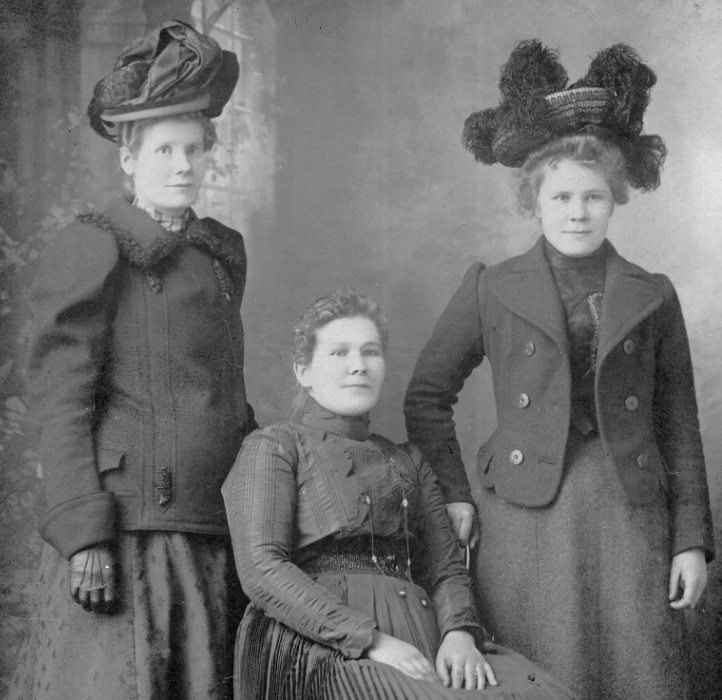
the Peltomaa sisters
In the
late 1800s several members of the Peltomaa (meaning “Field Land” in
Finnish) family moved from their farm near Raahe, Finland to the United
States. Brothers Kusta and August went to the US but returned to
Finland. Brother Petter stayed in the US as well, but he seems to have
gone to Canada (possibly Kamloops, BC) and disappeared from family
history. This will be the
story of the three sisters who all first came to the Black Hills of
South Dakota, as best as I can recreate it.
The Black Hills are mostly pine and spruce forested, with some aspen and other trees. The hills vary from small meadows to steep canyons, with small streams running in many of them. The climate is nice in the summer but can get harsh in the winter. In other words, it's a lot like parts of Finland. In fact my friend who came from Helsinki to visit me said one time was enough playing tourist here because it was so much like Finland anyway.
In 1874 gold was discovered in the Black Hills, and in 1876 a huge rush of people came there to seek their fortune, despite the United States treaty with the Native Americans giving them the entire Black Hills area. The federal government had tried at first to enforce the treaty, rounding up interlopers and sending them out to nearby forts. But by the spring of 1876 they gave up, re-negotiated and fought the tribes in the area, and allowed the rush to continue unabated.
Meanwhile, parts of Finland, generally made up of farmers, had been wracked by a famine from 1866 through 1868, which killed an estimated 150,000. Also most all farm land had been claimed so there was nowhere else to spread to for the new generations. Finns began moving to Sweden and other countries looking for opportunity. Starting with the copper mining area of Calumet, Michigan in about 1864, Finns began a large migration to the US which by 1924 numbered about 350 thousand. News of the Black Hills gold bonanza reached Europe, and many there thought it a good idea to try their luck, including many Finns. Some had mining experience, some were just looking for a better life, and some were just teenagers heading out on their own. The city of Lead, which turned out to be the center of gold mining, became a hodge-podge of ethnic areas that to this day have signs indicating where each nationality tended to live, including the Finns. This division was mostly due to language barriers, and cultural and family ties. Newcomers were certainly helped by having people who spoke their language already present when they made the move.
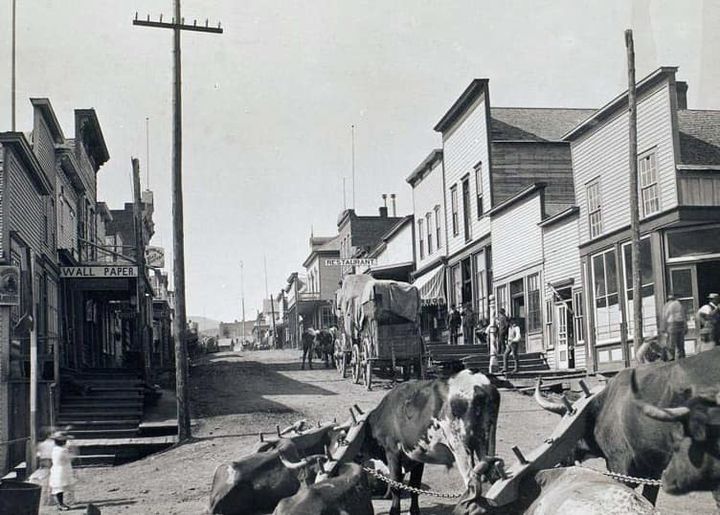
Main Street in Lead, South Dakota, late
1800s
For many immigrants their move was beneficial, although there was nothing easy about heading thousands of miles from home and starting life in a mining town. Here are the three Peltomaa sisters' stories.
HILMA
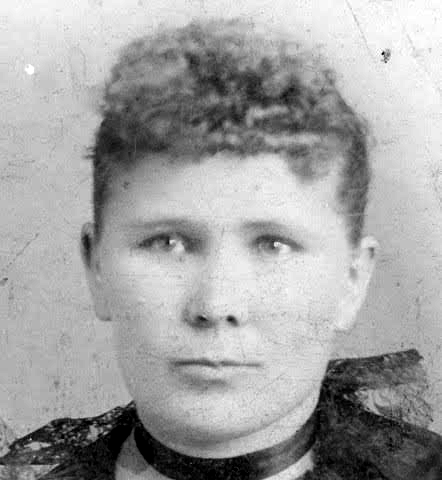
Hilma Peltomaa
Hilma Peltomaa was born in 1866 on a farm south of Raahe, Finland as the second of eleven children. She came to the US in about 1889. She somehow decided to move to Lead, South Dakota, probably on advice from a friend or relative. By this time many Finns were already living and working in the area so she would have heard of the opportunities and descriptions of the hills. I'm not sure if she went alone or with another family member or friend. The city of Lead in 1890 had a population of about 2,600. It was a crowded, hilly, noisy place where homes were shoe-horned into spaces around the mining properties.
After living in Lead a few years, Hilma married Finlander John Rova (b. 1863, d. 1940, became a US citizen in 1892) in 1894 and they lived in Roubaix about 8 miles southeast of Lead. Roubaix probably maxed out in size at about 500 in 1905 or so. Here they raised cattle at the eastern edge of town on about 73 acres. The Rovas did well financially and in 1904 added on to their already large house. The town itself also grew as the new owners of the Cloverleaf Gold Mine invested heavily into making the mine productive.
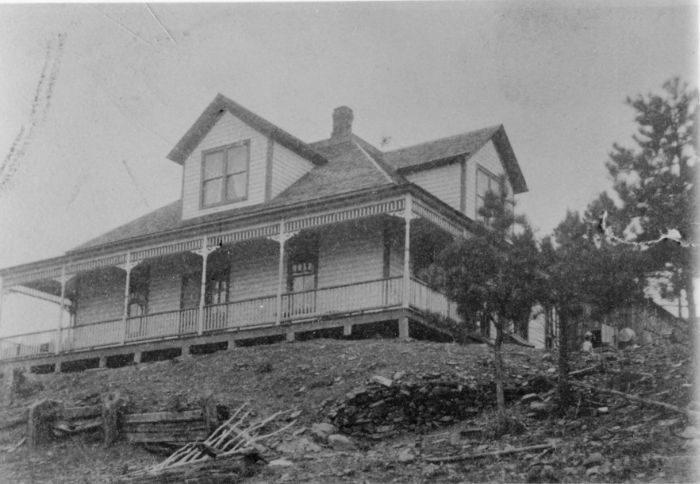
Rova house, Roubaix
The Rova children:
Enos (son) (b. 9/8/1894), In 1907 Enos
was shot by a .22 rifle in the stomach and was not expected to live, but
he is listed as surviving his wife who died in 1945.
Vieno, son (b. 1899)
Hazel (b. 1902, d. 1987) married Albert Jennings
Ina (b. 1904), married Walter Dean
Uno (b. 1910, d. 1957)
In 1913 they sold their Roubaix property to the Balanders and the family moved to east of Elmira, New York on a 160 acre farm. This was an area where many Finns at the time were moving to, beginning in about 1909. The Deadwood newspaper noted on Rova's move that "Few people realize the great bargains to be obtained in the so-called abandoned farms of New York and the New England states. In many cases they can be purchased for less than the actual cost of the buildings..." [Deadwood Pioneer-Times, 2/20/1913]. However, the actuality was not so rosy. "In studies of the use of this soil, agricultural economists reported that the three towns had from sixty-four to eighty per cent of their land in the two lowest land classes regarded as unfit for agriculture and as better suited for forestry and recreational purposes. The rest of their land, moreover, was mainly included in the poorest of three other land classes designated as suitable for agriculture." [In the Trek of Immigrants. A. William Hoglund. 1960] The Finns who did move onto these farms eventually pooled their resources to eek out a living on cheap but poor farm land, especially raising chickens.
In New York the Rovas moved several times but always in the same general area. They lived also in the small communities of Candor, Endicott, and Barton. I don't know where their farm land was nor whether they also sold that property.
Hilma died October 3, 1937 near Bradford, Pennsylvania. She had moved in with her daughter Mrs. Albert Jennings as she was infirm and needed care. She and John (died 1940) are buried in Halsey Valley, NY.
ALMA
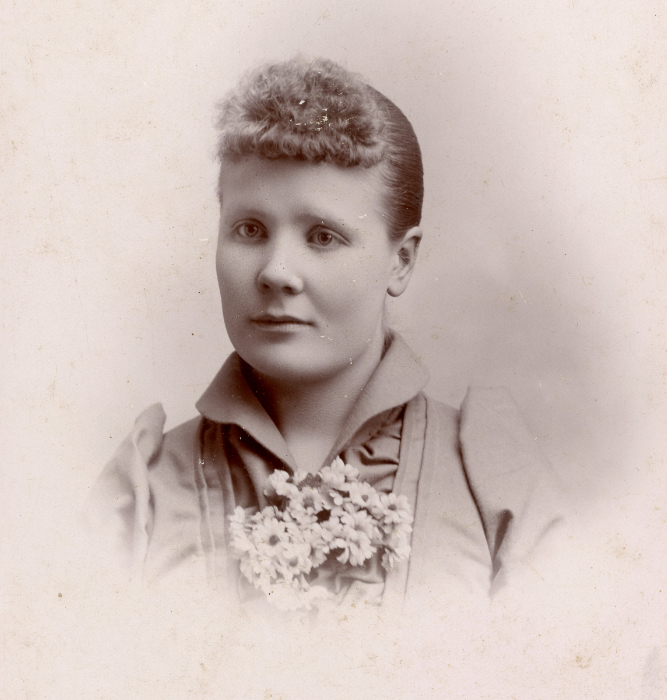
Alma Serafina Peltomaa was born June 2, 1871. She came to the Lead area in 1890 on the heels of her sister Hilma. She married Jacob O. Lahti, who was from Kemijärvi, Finland. They were married in Lead 11/21/1893 and lived on N. Bleeker Street. Jacob (1862-1924) had come to the US in 1882, doing mining work in Michigan and Montana before arriving in Lead. He then ran a bar in Terraville, very close to Lead. The largest nationality in Terraville was Finns. From about 1898 to 1900 Jacob tried his luck mining in the Yukon, then returned to Lead. He then went north with some friends to homestead out in the plains north of Lead about 90 miles. In about 1905 the family moved tthere as well. The tiny town of Buffalo was established in the area about 1909 to support the ranchers. This area is generally grassy plains with small buttes sticking up here and there. Today there are oil wells to the north, and the plains to the east are known for dinosaur bones. It is a dry climate that can be quite harsh in the winter.
Jacob and Alma Lahti
The Lahtis bought more ranch land starting in 1915 in the same area northwest of Buffalo. Over the next few years they compiled more land along meandering but dry Rush Creek, paying $2.50 per acre for some of it. Here they stayed, raising sheep on what would build up to over 1000 acres.
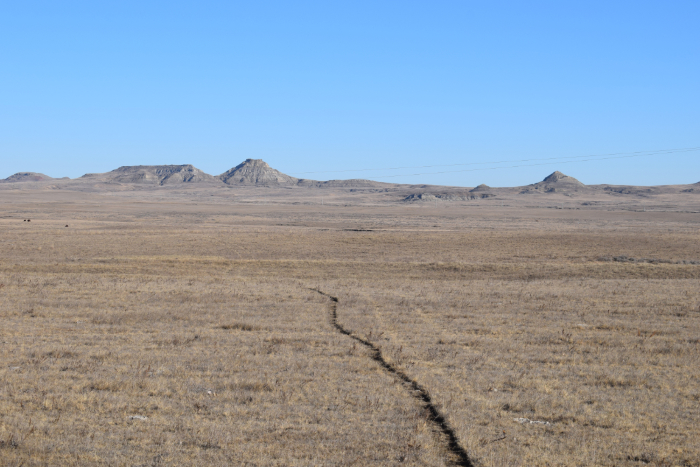
the Lahti Ranch, with Lahti Butte in the
background
Homesteading at this time meant the federal government would essentially give you 160 acres if you lived on it and “improved” it in particular ways within a certain time period. There was little competition here, hardly any government, and neighbors were distant and friendly. The rail line reached Belle Fourche, about 60 miles south, allowing for markets for sheep and cattle. Life was not easy by any means, but it was cheap and open for growth.
These were plenty of natural difficulties. January 12, 1916 it got to -57F in Harding County - the 2nd coldest day ever recorded in South Dakota. The winter of 1919 was especially cold and ranchers lost a lot of stock. That summer was severely dry and hot, at the same time the influenza epidemic hit. In the spring of 1920 a tornado ripped through the county, though I don't know if the Lahti ranch was affected.
One story of the time was of a notorious wolf named “Three Toes” because his prints showed a wound he had. This wolf seemed to enjoy killing for killing's sake rather than just for food. The Lahti ranch was particularly hit by Three Toes after Jacob had purchased 34 rams for his ranch. Within a month Three Toes had killed them all, before a hired hunter finally trapped the psychopathic wolf. Today you can stay at the Three Toes Campground in Buffalo.
A butte just northeast of their property is known as Lahti Butte.
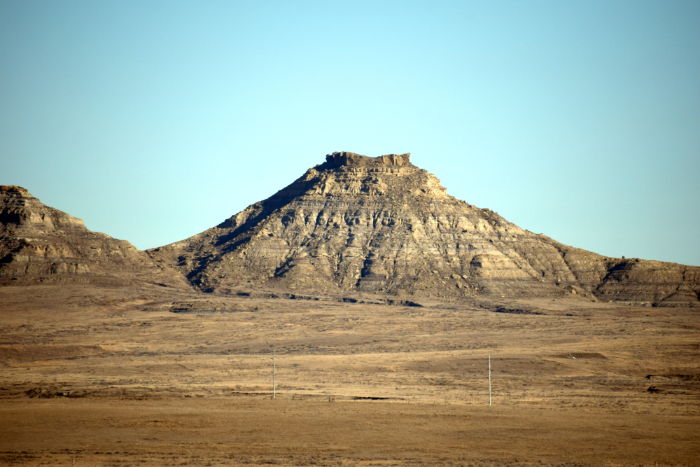
Lahti Butte
Their children were:
Eino Lahti - b. 1900, d. 1948, married Blanche Peterson
Lucina – b. 10/18/1896, d. 10/15/1979
Hubert – b. 1902, d. 9/23/1923
Vivian – b. 5/23/1909, d. 2005, taught in Spearfish
John – b. 1911, d. 1982
Kenneth – b. 7/15/1914 d. 1991, married Valery D. Gardner
Jacob died in 1924. Alma died in 1936 in Buffalo. Her sister Edith and Edith's husband Benjamin Hastie were present when Alma died. Jacob, Alma, and Hubert are buried in the Grand River Cemetery southwest of Buffalo. The ranch is no longer in the family.
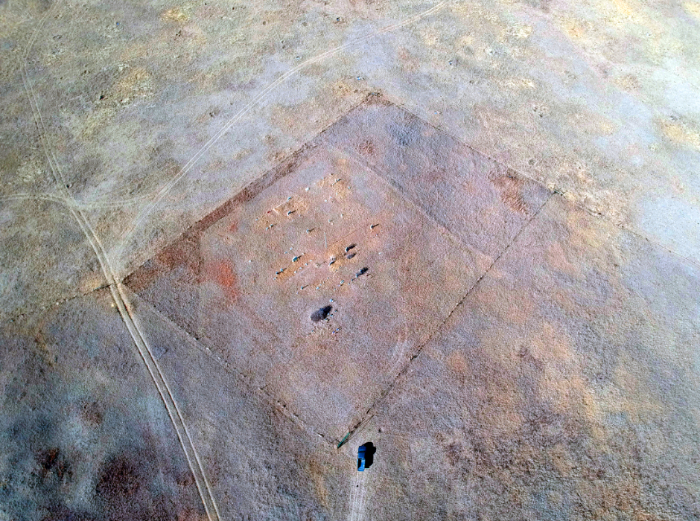
birds eye view of Grand River Cemetery
near Buffalo
EDITH
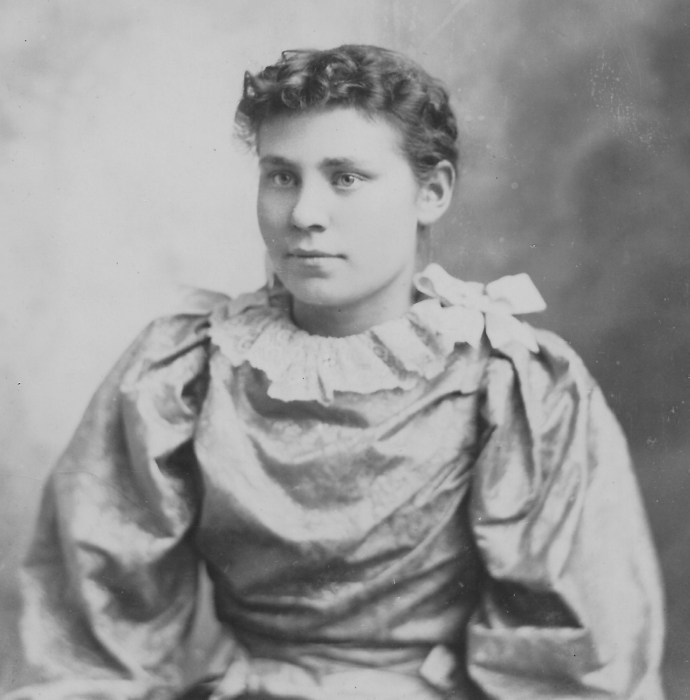
Edith Peltomaa
What got me interested in this writing project was a trip to my relatives in Finland in 1987. They had a photo album from 1899 that one of the brothers brought back from the US. In it were photos with studio names from Lead and Deadwood, SD. There was one photo that looked a bit familiar to me. Since nobody knew who any of those people were for sure, they let me have that photo. Recently I compared it to a photo we had of my great grandmother Edith, and I think that also is a photo of her when she was first here in the US, just 16 years old.
Edith Peltomaa (b. 9/23/1881, d. 1950) was the 2nd youngest of the 11 siblings. She came to Lead in 1897, probably staying with her sister Alma. She met Victor North, and they married April 3, 1903. The newlyweds moved to Roubaix where Victor worked in the Cloverleaf (aka Uncle Sam) gold mine. The Cloverleaf was just on the south edge of town. It closed in 1905 after a cave-in deep below damaged the water pumps that kept the mine dry. That must have been when Victor went to work at the Lucky Strike mine a few miles down Nemo Road. The family only spoke Finnish until the children started going to school, but I think Victor must have known English since he had been in the US military. By April of 1914 they had 5 children – Mabel (10), Lillie (9), Rosie (7), Freddie (4), and Irene (2) - and Edith was 7 months pregnant. But Victor, who had been sickly from malaria which he caught in the Spanish American war, died age 34. Immediately Edith was in a predicament with no income. Fortunately, Victor's mother Christofina, living in Galena at the time, took the family in immediately. Lillie recalled that they didn't even go home after school that day but went right to Galena about 3 miles away. 6 weeks after Victor's death, Edith gave birth to twins Viola and Victoria.
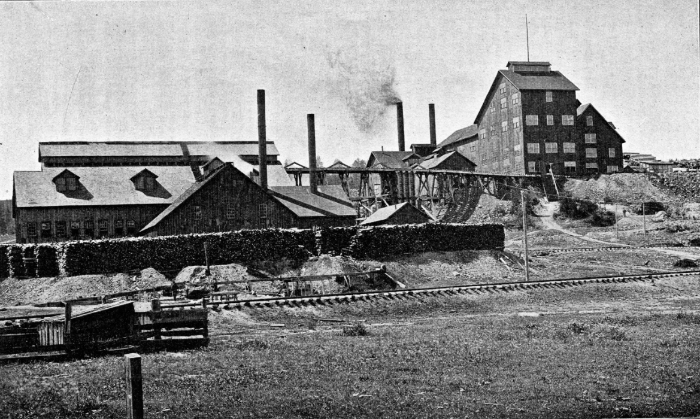
Cloverleaf (aka Uncle Sam) Mine in Roubaix
My grandmother Lillie was 9 years old at this time, and mostly remembers how poor they were. In November 1914 the county chose to give Edith a widower's stipend of $30 a month. At that time the average wage was about $3 a day, so you can see that with 8 mouths to feed, that didn't go so far. But Edith sent the kids to school in Galena after settling in. They had been going to the Roubaix school.
They lived with Christofina about a year before they found a cabin for themselves to rent. Eventually Edith also got a small military pension from Victor's service, and she worked odd jobs as she could.
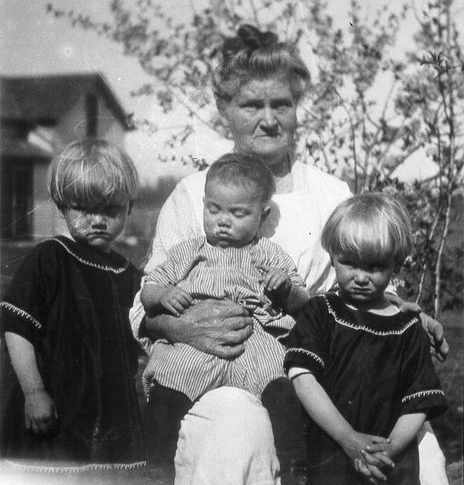
Christofina North-McAvoy
As she got older, Lillie worked in different places in Galena, including the Borsch house, which was a popular eating establishment. Lillie recalled one time when Mrs. Borsch was gone briefly and someone called to say they were coming out and would like the chicken dinner. Lillie and Rosie started preparing, but they could not bring themselves to kill a chicken. Fortunately, Mrs. Borsch came back in time to prepare that part of the meal.
Lillie went through 8th grade in the Galena school, but after that the school was closed for months due to the influenza epidemic traveling the country, and that was the end of her education. Several Galena residents died from the epidemic.
Edith's children were:
Mabel b. 7/11/1903, d. 2004, married Watkins
Lillian b. 8/9/1904, d. 8/9/1999
Rosie b. 2/4/1906, d. 1990, married Chester Borsch
Irene b. 6/22/1911, d. 1993, married Charles Nathan
Freddie b. 1909, d. 1930
Victoria b. 8/3/1914, d. 2004, married Peed
Viola b. 8/3/1914, d. 2004, married Pleas
In 1934 Edith married fellow Finn Benjamin Hastie of Lead. They lived at 330 Old Abe Street surrounded by the Homestake mine buildings and activity. Benjamin died in 1940. Later Edith moved in with her daughter Victoria in Seattle, where she died in 1950.
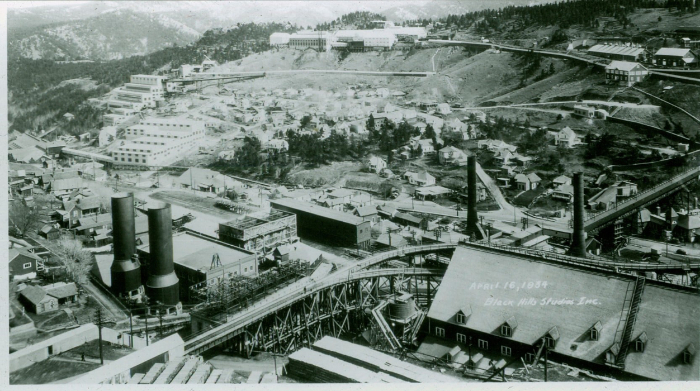
the view of Lead taken from above the Hastie
home on Old Abe Street
* * * * * * * *
The Peltomaa family in Finland:
Johan Peltomaa (b. 1841, d. 1/26/1908) – Greta Häntylä (b. 10/19/1840, d. 9/22/1905)
-
Anton Albert (b. 1/4/1863, d. 12/28/1904), married Maria Elvira Siniluoto?
-
Hilma (b. 1866, d. 1937 in Bradford, PA. To US in 1889, married John Rova in Roubaix in 1894)
-
Johan August (b. 8/24/1867, d. 5/11/1923) married Sofia Hannuksela. To US and back
-
Olga Maria (b. 6/12/1869, d. 6/12/1869)
-
Alma Serafina (b. 6/2/1871, d. 1936), married Jacob Lahti lived in Buffalo, SD
-
Karl Gustat (b. 1/9/1873), to US and back
-
Hilda Selina (b. 8/16/1874, d. 1943) married Juho Andreas Mattila
-
Senja Matilda (b. 2/6/1877, d. 3/20/1963) married Matti Orava
-
Petter Aleksander (b. 3/10/1879) came to the US in 1905
-
Edith (b. 9/25/1881, d. 1950), married Victor North, and later Benjamin Hastie
-
Selma Lydia (b. 31 Dec 1883 d. 10 Jan 1886)
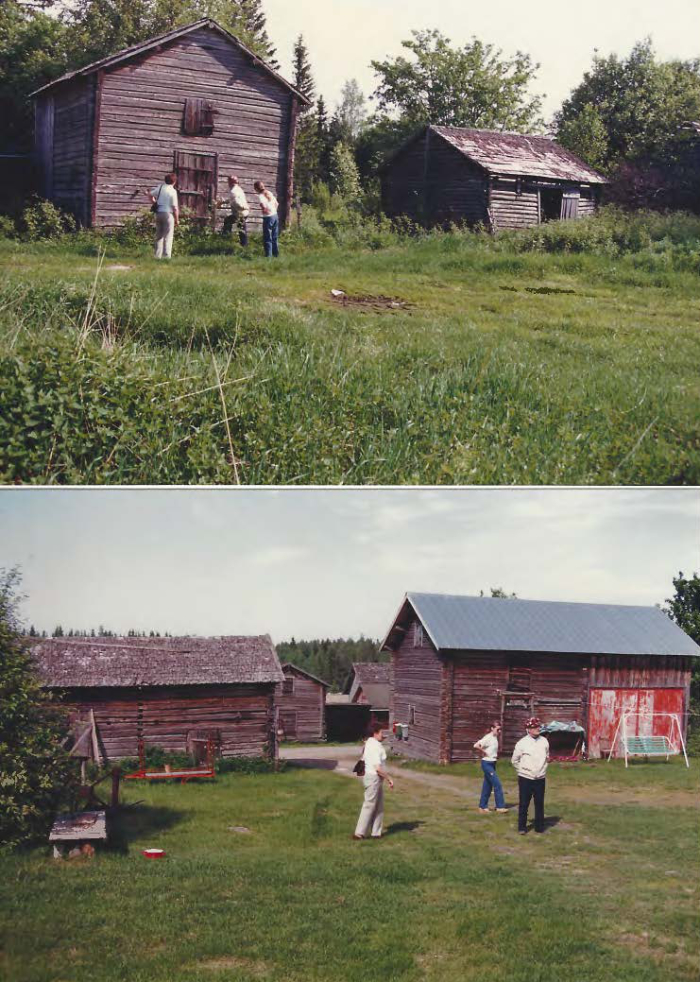
the Peltomaa farm in Saloinen, Finland, 1987